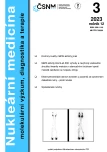Effect of lymphodrainage of lower extremities in patients with a diabetic foot syndrome – a pilot study
Authors:
O. Lang 1,4; V. Prýmková 2; B. Daňhová 3
Authors‘ workplace:
Oddělení nukleární medicíny
1; Interní oddělení
2; Rehabilitace, Oblastní nemocnice Příbram
3; Klinika nukleární medicíny, 3. LF UK a FN Královské Vinohrady Praha 10, ČR
4
Published in:
NuklMed 2023;12:54-57
Category:
Original Article
Overview
Introduction: Peripheral autonomic neuropathy and vasculopathy are the most frequent causes of the difficulties in patients with a diabetic foot syndrome. These disorders can cause the increased accumulation of interstitial fluids and, thus, the worsening of tissue condition. Lymphodrainage is a procedure, which increase the interstitial fluid outflow from the extremities via the lymphatic system. Therefore, we investigated an effect of lymphodrainage on subjective feeling of patients with a diabetic foot syndrome.
Material and methods: Lymphodrainage was performed in 8 patients. There were 5 female and 3 male, average age of 60 (50-84) years. Intermittent pneumatic compression of lower extremities was performed in 7 patients, manual lymphatic drainage in one. We assessed the clinical effect (improvement of feeling of edema and heavy legs) in relation to transport capacity of lymphatic system and presence of dermal backflow. Paired t-test was used for comparison.
Results: Subjective improvement after lymphodrainage reported 3 patients (38 %) (group 1), 2 of them (66 %) showed dermal backflow. 5 patients (62 %) (group 2) did not refer any or questionable effect, dermal backflow had only 2 patients in this group (40 %). Transport capacity of lymphatic system did not differ between these two groups even for single extremities.
Conclusion: Lymphodrainage of lower extremities improved subjective feeling in one third of our patients, two thirds of them had a dermal backflow. However, there was no significant difference in lymphatic transport capacity between patients who improved and who did not. We, therefore, assume, that lymphatic transport capacity reached it maximum and even lymphodrainage cannot increase it. Thus, the treatment should be directed to decrease interstitial fluid production.
Keywords:
diabetic foot syndrome – lymphodrainage – clinical effect
Sources
- Bem R, Jirkovská A, Dubsky M, et al. Role of quantitative bone scanning in the assessment of bone turnover in patients with Charcot foot. Diabetes Care. 2010;33:348-349. doi: 10.2337/dc09-0950. Epub 2009 Nov 23. PMID: 19933988; PMCID: PMC2809280.
- Lang O, Kuníková I. Možnosti scintigrafie u pacientů se syndromem diabetické nohy. NuklMed 2019;8:52-59
- Jirkovská A. Syndrom diabetické nohy z pohledu internisty podiatra. Vnitř Lék 2016;62(S 4): 4S42–4S47
- Belcaro G, Laurora G, Cesarone MR, et al. Microcirculation in high perfusion microangiopathy. J Cardiovasc Surg (Torino) 1995;36:393-398
- de Sire A, Inzitari MT, Moggio L et al. Effects of Intermittent Pneumatic Compression on Lower Limb Lymphedema in Patients with Type 2 Diabetes Mellitus: A Pilot Randomized Controlled Trial. Medicina 2021:57;1018-. https://doi.org/10.3390/medicina57101018
- Kubinyi J, Knotková V, Hrbáč J et al. Lymfoscintigrafie, provedení vyšetření a jeho interpretace. NuklMed 2018;7(S2):1-4
- Kahn, R. Report of the Expert Committee on the Diagnosis and Classification of Diabetes Mellitus. Diabetes Care 1997;20:1183.
- Bouta EM, Wood RW, Brown EB, et al. In vivo quantification of lymph viscosity and pressure in lymphatic vessels and draining lymph nodes of arthritic joints in mice. J. Physiol. 2014;592:1213–1223
- Davis MJ, Scallan JP, Castorena-Gonzalez JA, ez al. Multiple aspects of lymphatic dysfunction in an ApoE−/− mouse model of hypercholesterolemia. Front. Physiol. 2023;13:1098408. doi: 10.3389/fphys.2022.1098408
- de Sire A, Losco L, Cisari C, et al. Axillary web syndrome in women after breast cancer surgery referred to an Oncological Rehabilitation Unit: Which are the main risk factors? A retrospective case-control study. Eur. Rev. Med. Pharmacol. Sci. 2020;24:8028–8035.
- de Godoy JMP, Azoubel LMO, de Godoy MFG. Intensive treatment of leg lymphedema. Indian J Dermatol. 2010;55:144–147
- Müller M, Klingberg K, Wertli MM, et al Manual lymphatic drainage and quality of life in patients with lymphoedema and mixed oedema: A systematic review of randomised controlled trials. Qual. Life Res. 2018,27,1403–1414.
Labels
Nuclear medicine Radiodiagnostics RadiotherapyArticle was published in
Nuclear Medicine

2023 Issue 3
Most read in this issue
- Effect of lymphodrainage of lower extremities in patients with a diabetic foot syndrome – a pilot study
- Technical note on quality control tests of dose calibrators
- AtomLab 500 Radionuclide Calibrator: Advantages and Disadvantages of Built-in Attenuator Tube Linearity Test vs. Source Decay Method
- Nukleární medicína a MUDr. Eva Hoffmannová, CSc Kolín
